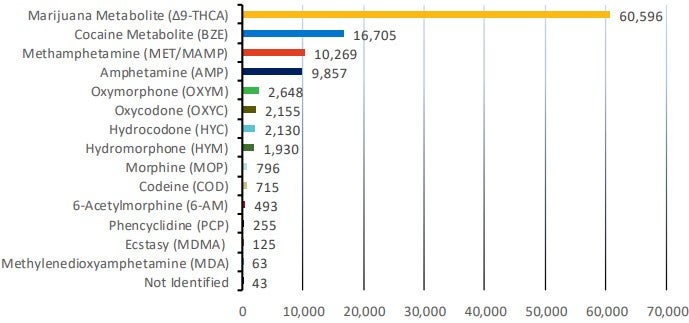Drug violations for truck drivers increased 10.2% in 2021 over 2020 in the first full-year data comparison compiled by the federal Drug & Alcohol Clearinghouse.
While the number of actual positive drug tests increased only 3.1% to 55,223 (refusing to take a test is also considered a violation), a year-to-year comparison of 15 drug categories within the Federal Motor Carrier Safety Administration-run clearinghouse revealed that positive tests for cocaine and marijuana increased 10.4% (7,940 to 8,765) and 5.3% (29,511 to 31,085), respectively, in 2021 compared with 2020. Positive tests in all other categories combined fell 4.6% (16,106 to 15,373).
The only other drug that registered an increase in positive tests was MDA, a manmade hallucinogen, which increased from 30 positive tests in 2020 to 33 in 2022.
Alcohol violations also increased, jumping 26.7% from 1,122 in 2020 to 1,422 in 2021. Overall drug and alcohol violations combined increased 10.6% to 113,569.
Full preemployment queries into the database — which employers are required to conduct when hiring a CDL/CLP holder — increased 42% in 2021 compared to 2020, reflecting the hiring churn that occurred in the trucking industry as carriers struggled to keep up with consumer demand.
Of 104,840 drivers who have registered at least one drug or alcohol violation in the clearinghouse since its official start in January 2020, 81,052 (77%) have yet to complete the return-to-duty process and remain prohibited from driving commercially.
According to FMCSA data, marijuana is by far the most prevalent drug used in the trucking industry, ranking 25% higher than all other substances combined that were reported into its database (see chart).

However, a study released in January backed by major truckload carriers found that FMCSA’s clearinghouse may be underreporting cocaine use by truckers because hair test results — regarded by many as a more accurate way to test for drugs — are not currently accepted by the U.S. Department of Transportation for commercial drivers.
The Trucking Alliance, which paid for the study, used it to bolster its argument that hair testing should be a DOT-approved alternative for pre-screening and random drug tests.
But the Owner-Operator Independent Drivers Association’s research arm reviewed the report “and found no reason to believe that crashes would be reduced” if hair testing were federally approved as an alternative.
“What the Trucking Alliance is claiming cannot possibly be extrapolated to the entire industry,” said OOIDA President Todd Spencer. “They really should be taking a closer look at why their carriers are so attractive to potential employees that use illegal drugs. And, any shipper that uses those companies might also take note.”
